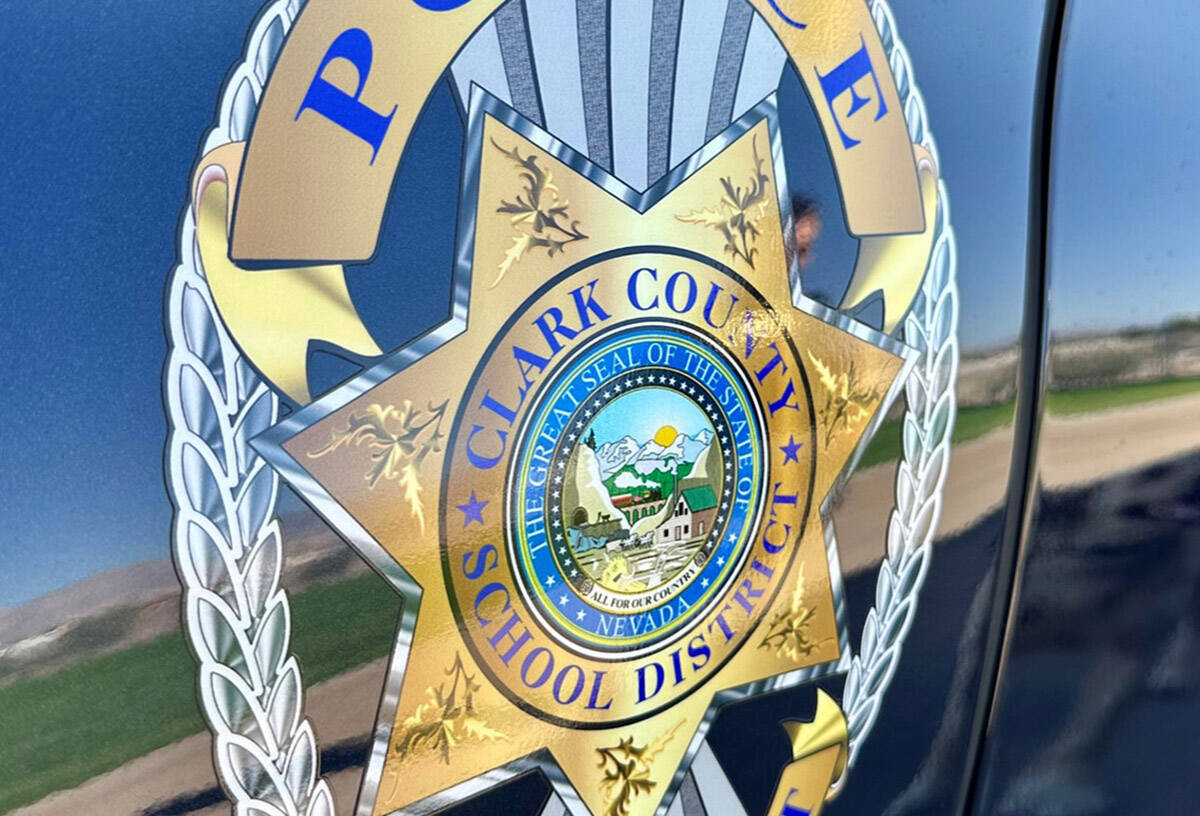Code of conduct: What will get a CCSD police officer fired?
Amid nearly 2,000 pages of heavily redacted public records, the Clark County School District released its most recent code of conduct for the district’s police department, showing what consequences officers face for violating it.
The nine-page document hosts a matrix of offenses, along with their corresponding sanctions.
The CCSD Police Officers Association collaborates with the department to establish this code of conduct, said Adam Levine, general counsel for the association.
The association, the CCSD police department’s union, has bargained a “progressive discipline policy” for when officers violate the code, Levine said.
There are seven classes of sanctions. If an offense is classified as a 1, an officer committing this offense for the first time can expect to receive an oral warning. But if an offense is classified as a 7, an officer can expect an immediate dismissal.
Some fireable offenses are straightforward, such as willfully using an illegal drug or being involved in a felony. Others, like membership, affiliation or advocacy in subversive groups or their principles, are not so straightforward.
Some changes still in progress
Levine explained that while the union has signed off on the majority of the code of conduct, some clauses are still being worked out.
“Guys, what is a subversive group?” he mused. “We need to fix that.”
But some offenses have not been the subject of conversation around changing the code.
In the current version of the code, which went into effect in December of 2020, using bias or racial profiling in the performance of police duties has a sanction range of 4 to 7.
This means that on the first offense, depending on the severity, an officer may receive a written reprimand. This offense does not rise to the level of a fireable offense until the third time an officer uses bias or racial profiling, according to the sanctions chart.
Levine, who noted that this range was chosen before he became involved in the union, said this clause has “just been in there forever.”
“Somebody a long time ago just thought this is what is should be,” he said.
Since he became involved in the union, Levine said he has never seen an instance of an officer committing this offense. And because there has not been an example, “we’ve never looked at it to see if it’s appropriate,” he explained.
Lt. Bryan Zink of the Clark County School District Police Department said that while the chart of sanctions is broken down by first, second and third offense, the classification also depends on the severity of an offense.
“It could be a first offense, and it could be a 7,” Zink said.
Part of the progressive discipline policy is that officers receive a sanction that should, in some way, correct their behavior. Zink explained that this can be training or counseling.
But if somebody committed an offense the first time, underwent training and then did it again, “Yeah, you have a problem with that officer,” he said.
Range of classifications
Some offenses, such as the excessive use of force, have a wide range of classifications — 1 to 7.
Zink said it helps to think of an offense like a law. “Different laws have different degrees of criminality,” he said.
If an offense has a broad range of possible sanctions, the severity of the offense, the number of times the officer has committed the offense and whether or not the officer was truthful about it are all factors that will be taken into consideration, Zink explained.
He said that complaints about a possible code of conduct violation can come through from citizen reports, a supervisor’s observation or a review of body camera footage. The complaints are then investigated by an internal affairs committee.
Some violations have narrower ranges. For instance, an officer speaking critically of someone’s nationality, color, sex or beliefs invites a sanction of classes 3 through 5.
Zink explained that the reason this offense is not immediately a fireable one is because the department would “hope that we would be able to handle that through re-education.”
He also emphasized that having this type of complaint in an officer’s folder would be “devastating to a law enforcement career.”
According to the code of conduct, if an officer does not re-commit an offense within three years, if they ever do it again it will be “considered a first offense for purposes of discipline.”
Levine referred to this policy as purging, although some sanctions can’t be purged. For example, if an officer is demoted or fired, this won’t change after three years.
But an oral warning, written reprimand or suspension could be removed from an officer’s record.
“It would pretty much be a clean slate,” Zink said. “Once it’s out of the file, it’s out of the file.”
He added that the CCSD police code of conduct evolves with a changing society. When a new law goes into effect that protects a class of people or targets bullying and harassment, the code will be updated.
“Since its inception in 1989, the CCSD Police Department’s Code of Conduct has evolved to meet current and future needs. Changes to the Nevada Revised Statutes, employee union collective bargaining, Clark County School District regulations, case law, and best practices are incorporated as they develop,” a CCSD spokesperson said.
If the code does change, every officer is sent a new copy to review and sign, according to Zink.
“They can’t really say, ‘Well, I wasn’t aware,’” he said.
Contact Estelle Atkinson at eatkinson@reviewjournal.com.
CCSD Code of Conduct 2020 by Las Vegas Review-Journal on Scribd






















